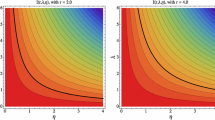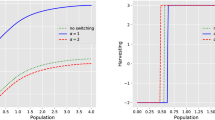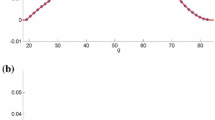Summary
Dramatic changes at thresholds in multiple stable ecosystems may be irreversible if caused by man. The characteristic return time to an equilibrium increases when a threshold is approached. A universal law for this increase is found, which may be used to forecast the position of a threshold by extrapolation of empirical data. Harvesting experiments on populations are proposed that can be used to verify the method. Preliminary harvesting experiments on rotifer populations display a good agreement with the theory.
Similar content being viewed by others
References
Agnew TT (1979) Optimal exploitation of a fishery employing a nonlinear harvesting functions. Ecol Modelling 6:47
Anderson RM (1979) The influence of parasitic infection on the dynamics of host population growth. In Population Dynamics; Anderson RM, Turner BD, Taylor LR (eds), Symp Brit Ecol Soc, Blackwell Scient Publ pp 245
Brauer F, Soudack AC (1979) Stability regions and transition phenomena for harvested predator-prey systems. J Math Biol 7:319
Clark WC, Holling CS (1979) Process models, equilibrium structures, and population dynamics: On the formulation and testing of realistic theory in ecology. In: Population Ecology, Halbach U, Jacobs J, Fortschritte der Zoologie 25:(2/3) Symposium, Mainz, 1978
De Angelis DL, Goldstein RA, O'Neill RV (1975) A model for trophic interaction. Ecology 56:881
Diamond JM (1975) Assembly of species communities. In: Ecology and evolution of communities Cody ML, Diamond JM (eds)
Goel NS, Richter-Dyn N (1974) Stochastic models in biology. Academic Press
Gulland JA (1975) The stability of fish stocks. J Cons int Explor Mer 37:199
Halbach U (1979) Strategies in population research exemplified by rotifer population dynamics. In: Population Ecology, Symposium Mainz, 1978. Halbach U, Jacobs J, (eds) Fortschr d Zool 25 (2/3), 1
Janzen DH (1970) Herbivores and the number of tree species in tropical forests. Am Natur 104:501
Le Creen ED, Kipling C, McCormack JC (1972) Windermere: Effects of exploitation and eutrophication on the salmonid community. J Fish Res Bd Can 29:819
Ludwig D, Jones DD, Holling CS (1978) Qualitative analysis of insect outbreak systems: The spruce budworm and forest. J Anim Ecol 47:315
May RM (1977a) Thresholds and breakpoints in ecosystems with a multiplicity of stable states. Nature 269:471
May RM (1977b) Togetherness among schistosomes: Its effects on the dynamics of the infection. Math Biosc 35:301
McQueen DJ (1975) Multiple stability and maximum stability in a model population. Can J Zool 53:1844
Ming Chen Wang, Uhlenbeck GE (1945) On the theory of the Brownian Motion II. Rev Mod Phys 17:323
Peterman RM, Clark WC, Holling CS (1979) The dynamics of resilience; Shifting stability domains in fish and insect systems. In: Population Dynamics Anderson RM, Turner BD, Taylor LR (eds) 20. Symp Brit Ecol Soc, Blackwell Scient Publ
Russell BD, Talbot FH, Domm S (1974) Patterns of colonization of artificial reefs by coral reef fishes. Proc Z Int Symp Coral Reefs 1:207
Sasaba T, Kiritani K (1975) A system model: a computer simulation of the green rice leafhopper populations in control programs. Res Pop Ecol 16:231
Schoener TW (1978) Effects of density-restricted food encounter on some single-level competition models. Theor Pop Biol 13:365
Simenstad CA, Estes JA, Kenyon KW (1978) Aleuts, sea otters, and alternate stable state communities. Science 200:403
Sutherland JP (1974) Multiple stable points in natural communities. Am Natur 108:859
Van Nguyen V, Wood EF (1979) On the morphology of summer algae dynamics in non-stratified lakes. Ecol Mod 6:117
Whittaker RH (1975) The design and stability of plant communities. Proc Int Congr Ecol The Hague 1974
Wissel C, Beuter K, Halbach U (1981) Correlation functions for the evaluation of repeated time series with fluctuations. ISEM Journal 3:(1–2) 11–29
Author information
Authors and Affiliations
Rights and permissions
About this article
Cite this article
Wissel, C. A universal law of the characteristic return time near thresholds. Oecologia 65, 101–107 (1984). https://doi.org/10.1007/BF00384470
Received:
Issue Date:
DOI: https://doi.org/10.1007/BF00384470




